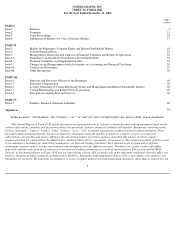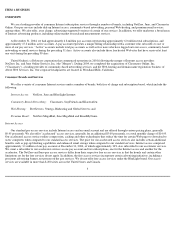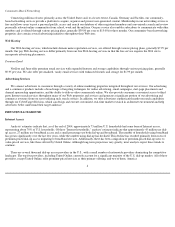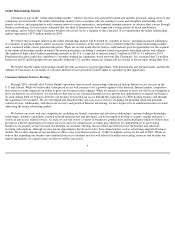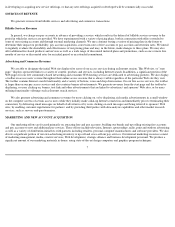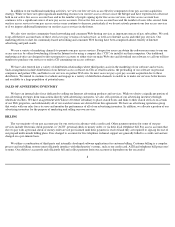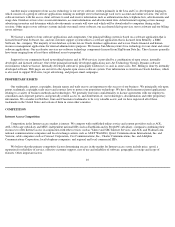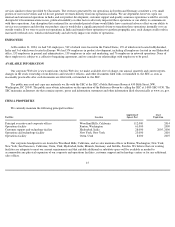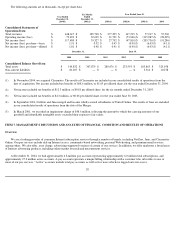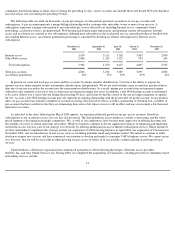Classmates.com 2004 Annual Report Download - page 13
Download and view the complete annual report
Please find page 13 of the 2004 Classmates.com annual report below. You can navigate through the pages in the report by either clicking on the pages listed below, or by using the keyword search tool below to find specific information within the annual report.
include a company's ability to dedicate significant resources to market its services, a company's ability to develop and introduce new features and
services, and general economic trends affecting the industry. While we believe that we compete favorably with respect to price and many of
these other factors, many of our competitors have an advantage over us with respect to specific factors, particularly customer support and scope
of features.
The number of U.S. households using broadband has grown significantly over the last few years and is expected to continue to grow.
Broadband access, which includes cable, DSL, satellite and wireless, generally offers users faster connection and download speeds than dial-up
access for a higher monthly fee, currently ranging from an estimated $27 to $55 per month, although offers for promotional periods have been as
low as $10 per month. Pricing for broadband services, particularly for introductory promotional periods, services bundled with cable and
telephone services, and services with slower speeds, has been declining and the pricing gap between broadband and premium dial-up access
services has been narrowing. As a result of broadband adoption, the total number of dial-up accounts in the U.S. has declined and industry
analysts predict that it will continue to decline. The decline in the size of the dial-up market could accelerate significantly if broadband services
become widely available at lower prices or if there is significant consumer adoption of broadband applications, such as online video, telephony
and music downloads, which depend upon connections that provide significant bandwidth. We currently offer a broadband service in Nashville
and Indianapolis through Comcast Corporation's cable systems. The service, however, is not value-priced and we have had a minimal number of
subscribers sign up for it. While we review the possibility of offering broadband services from time to time, we currently do not plan to offer
broadband services on a significant scale, which will adversely impact our ability to compete for new subscribers and to retain existing
subscribers.
Our success historically has been based on offering dial-up Internet access services at prices below the standard monthly pricing of the
premium dial-up services of most of our major competitors. Competition from broadband providers and value-priced providers such as United
Online has resulted in significant declines in the number of subscribers to premium priced dial-up services over the last few years. In response to
this competition, many competitors have engaged, and are likely to continue to engage, in more aggressive pricing of their dial-
up services under
their premium-
priced brands to obtain and retain users, such as offering up to six free months of service or extended periods of free or discounted
pricing. AOL, through its Netscape subsidiary, EarthLink, through its PeoplePC subsidiary, and a number of small providers now offer value-
priced services at prices similar to our prices and which are, in some cases, priced below the prices of our services. Partially in response to this
competition, we have become more aggressive in offering discounted services and one or more free months of services in order to obtain and
retain pay access accounts. Despite these measures, our growth in pay access accounts was limited during the June and September 2004 quarters
and our number of access accounts declined in the December 2004 quarter. We believe increased competition, including pricing competition, has
adversely impacted our ability to obtain new pay access accounts and to retain our existing accounts, is likely to adversely impact our ability to
maintain or grow our pay access account base in the future and may make it more difficult to maintain the current pricing of our services.
Price competition is particularly relevant to our ability to maintain or grow our accelerator subscription base. A significant portion of our
growth in revenues and profitability since early 2003 has been attributable to new subscribers to our accelerator services. When we began
offering this service in early 2003, many of our competitors either did not offer a similar service or charged substantially more than we charge
for a similar service. Since that time, most of our competitors have started offering a similar service, and several competitors have either
decreased their price for these services or have bundled these services into their premium services with no additional fee. Many competitors now
market these services as a feature of their value-priced services at no additional cost and these services are now offered, in certain cases, at a
price point similar to or lower than our standard price. In
11



